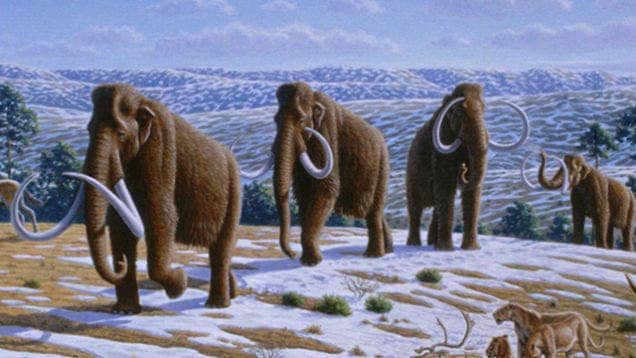Cloning the woolly mammoth is a life long dream for many geneticists and biologists, but the challenges are numerous. Now, we’ve come a step closer after researchers replaced snips of elephant DNA with those from the woolly mammoth. The changes they’ve made so far are stable, and even though there’s still much work ahead, little by little scientists are building the mammoth’s genome one piece at a time. Next stop: actually cloning the mammoth, effectively resurrecting the species back from the dead.
The last mammoth likely lived 3,200 years ago. Some scholars believe that their extinction was driven by excessive hunting, but there’s a growing consensus that humans alone weren’t to blame. Instead, a combination of factors likely lead to their demise, most important of which was climate change. While the ice age killed the poorly adapted mammoths, thanks to it we at least now have a myriad of extremely well conserved specimens. For instance, a team of international researchers uncovered a 43,000 year old female from the Siberian tundra which still had well conserved muscles, kidneys and even blood! A team member was actually quoted as saying the decomposition was less severe than a six months old carcass.
While DNA can survive for a long while under the ‘freezer’, it’s far from being perfect. In other words, it’s impractical for cloning purposes, since many bits and pieces have been damaged by the environment. This is why so many are skeptical of so called mammoth cloning. “C’mon, it’ll never happen. Not in my lifetime,” said Webb Miller, a Penn State computer scientist and genomicist who helped decipher the genetic code of a woolly mammoth.
Yes, sure, but what if you piece it together? This is what George Church, professor of genetics at Harvard University, and colleagues have been doing for the last couple of years. Using a novel technique they’ve replaced sections of elephant DNA with the mammoth genes. Since the two species are very similar, the reasoning is to only piece together those pieces that are distinct. For instance, those genes that code body hair or the longer ears.
“We now have functioning elephant cells with mammoth DNA in them. We have not published it in a scientific journal because there is more work to do, but we plan to do so,” Church said.
Church’s efforts are only the last to come to attention. At least three other team are working independently to clone to mammoth. As to Church’s research, there are a lot of loose ends that, to me at least, look very challenging if not impossible to fix. First of all, are they certain they can find the function of all the mammoth genes they’ve uncovered so far? If they do clone a so-called mammoth, will it be a mammoth in the first place or just a hybrid? Nevertheless, it would be a fantastic scientific achievement. Yes, there are critics who argue this is not only useless, but unethical. Why clone an extinct species, when we can barely avert extinction today! A while ago, I reported a new analysis conducted by Nature which found that 41% of all amphibians on the planet now face extinction while 26% of mammal species and 13% of birds are similarly threatened. Even more species might become at risk, arguably, once an extinct species is resurfaced through cloning since extinction itself would become far less dramatic. “You can always bring it back.” But why renounce such a powerful tool? Yes, humans have been and are still highly irresponsible, but at least…we’re trying to fix it. Some of us at least.










